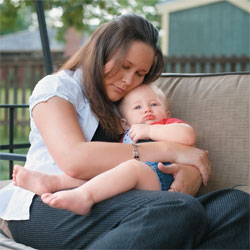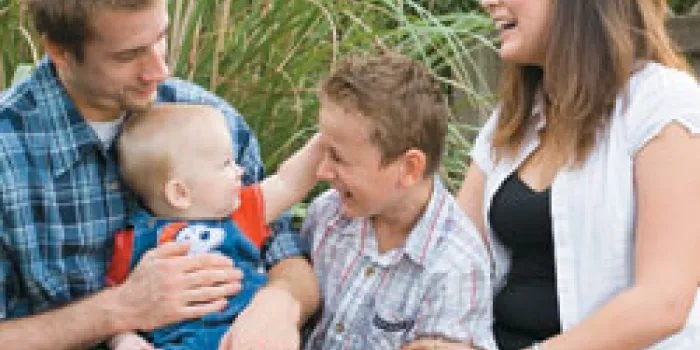When Mike and Vanessa Sidwell’s son Jaiden was diagnosed with severe hemophilia A four days after birth, the couple was overcome with heartache. They cried; they wondered whether Jaiden would live or die; they blamed themselves; and they grieved over the dream they once had of a perfect baby.
“All of a sudden, it didn’t seem perfect,” Vanessa says from her home in Pleasant Hill, Missouri. “I thought the hemophilia would limit him a bunch, to where he’d be in a bubble and not be able to do anything. My husband thought the same thing.”
At birth, Jaiden had a cephalohematoma, a large bump caused by a collection of blood on the top of his skull. Within a couple of days, two small intracranial bleeds were discovered, and Jaiden needed two blood transfusions in four days. The Sidwells didn’t bring their son home from the hospital until he was one month old, at which time they started prophylaxis three days a week as a preventive measure. Today, Jaiden is six months old, 21 pounds and growing strong, says Vanessa, 26, who works full-time as a customer service associate for the local electric company. Her mother watches Jaiden during the day.
“He is healthy and happy,” Vanessa says. “We’ve learned a lot, and the staff at the hemophilia treatment center (HTC) at Children’s Mercy Hospital in Kansas City has been terrific. They helped me understand it’s not a deadly disease and that it’s different than it used to be. They comforted us, helped us get over the myths and taught us that there are ways to manage it. Now we are teaching our eight-year-old son, Jordan, how to deal with Jaiden’s hemophilia as well.”
The Sidwells, like other parents living with a bleeding disorder diagnosis, face a spectrum of challenges and emotions. They have learned where to go for medical help, how to deal with bleeds, how to pay for treatments, how to get the most out of their health insurance and how to take care of themselves by connecting with other parents of children with hemophilia.
The Sidwells have sought emotional and logistical support from friends, family and colleagues, and they have returned to church to find a supportive community there as well.
“This Is Your ‘Normal’”
When a child is diagnosed with hemophilia, one of the first steps for the family is meeting with a doctor, nurse and social worker at their local HTC. This initial meeting usually covers the basics of hemophilia and treatment for the disorder, and answers many of the parents’ immediate questions.
“If they haven’t experienced hemophilia before, it’s a lot to grasp at the beginning,” says Jeanne Lusher, MD, director of the Hemophilia, Hemostasis and Thrombosis Program at Children’s Hospital of Michigan in Detroit. “I tell them this is the beginning of a long relationship.” She says if a child is diagnosed shortly after birth, that gives the parents about a year during which the child will not likely require treatment (before he is walking, falling, tripping and bleeding). This can be a relatively calm period during which parents can educate themselves about the disorder.
 “We tell parents that they are their child’s best advocate,” Lusher says. “I tell them, ‘If you understand it, he’ll be a lot better off.’” She has a checklist of items to address with families, but a lot of what she shares depends upon the diagnosis and how much the parents know about hemophilia.
“We tell parents that they are their child’s best advocate,” Lusher says. “I tell them, ‘If you understand it, he’ll be a lot better off.’” She has a checklist of items to address with families, but a lot of what she shares depends upon the diagnosis and how much the parents know about hemophilia.
Getting through the first year comes as a huge relief to many parents, according to social workers. Compared to the feeling of shock just after diagnosis, the next stage feels a lot more comfortable, says Ed Kuebler, LCSW, at Gulf States Hemophilia and Thrombophilia Center in Houston.
“At first, it’s that whole shock and denial stage,” Kuebler says. “They’re getting bombarded with a lot of information. I advise them to read it in their own time, when they’re ready. And I tell them it’s going to be OK. After a year or 18 months, parents typically have a good understanding, so they can take a breath,” he says. “They’ve accepted that their child has a bleeding disorder, and it isn’t going away.”
Kuebler likes to remind parents to still have fun with their lives and not take it so seriously. “This is your ‘normal,’” he says. “‘This will be normal for your family.’ Once they grab onto that, they don’t struggle as much.”
Social workers say one of the most critical steps in moving forward after a diagnosis is bonding with other parents. “There is no one who understands your situation better than another parent living with a child with a bleeding disorder,” Kuebler says. “Find parents most similar to you and spend as much time around them as possible. You’ll learn the most that way.”
Some families get involved with the National Hemophilia Foundation’s (NHF’s) First Step Program, which offers social connections and practical, hands-on support for parents of children up to two years old.
Someone to Call on Christmas
Melissa Franzen learned how important it was to have connections with other parents shortly after her then-eight-month-old son Charlie was diagnosed with severe hemophilia B in November 2005. On Christmas Day 2005, Charlie climbed onto a step and fell backward. “I looked at my three-year-old daughter opening presents, and my heart just sank,” says Melissa, 33, who lives in Santa Barbara, California. “I thought, ‘What do I do now?’” She called a friend whose son had done something similar. The friend advised Melissa to take Charlie to the hospital.
“I knew she wouldn’t mind me calling her on Christmas,” Melissa says. “It’s just invaluable to have someone to call, no matter when it is. It’s all so scary, but after I talked to her, I knew it would be OK.”
“Parents need to get plugged in with other parents who have dealt with this,” says Bryce Kerlin, MD, director of the Hemophilia and Bleeding Disorders Program for the Hemostasis and Thrombosis Center at Columbus Children’s Hospital in Ohio. “Get involved with your local NHF chapter so you have someone to commiserate with and discuss things like school, gym and daycare. A lot of families would cope a lot better if they would do that.”
Melissa and her husband, Michael, had a lot to learn after Charlie was diagnosed. She admits that she once thought hemophilia was treatable with antibiotics and didn’t know anything about it. Since then, the couple has learned as much as they can about Charlie’s disorder, and Melissa has connected with other parents of children with hemophilia through the Hemophilia Foundation of Southern California, a chapter of NHF.
The Franzens moved to Santa Barbara to be closer to their pediatric hematologist so that treatments for Charlie would be more convenient. Before they moved, Melissa says, they had to take Charlie to the emergency room. “I’d walk into the ER, and they’d look at us like, ‘Oh my God, you’ve got a kid with severe hemophilia.’ They didn’t know what to do with him. Now, we have an HTC in L.A. and our pediatric hematologist in Santa Barbara. I feel like I have a strong medical team.”
The only joint bleed Charlie has had was in his ankle when he was first diagnosed. Melissa says he is an active two-year-old—he has hit his head many times and is constantly covered with bruises—but now he is talking and can let her know where it hurts. Melissa manages his infusions by herself at home, and Charlie—who understands that he hurts less after he is infused—picks out his own Band-Aids® afterward. When people ask him about his medical ID bracelet, he says, “I have hemophilia.” “In our family, hemophilia is normal, and it’s fine, and we’re not scared of it,” Melissa says. “I wouldn’t have said that a year ago.”
 Cindy Michael, MSW, LISW, at Northwest Ohio Hemophilia Treatment Center at Toledo Children’s Hospital, says her center’s philosophy is that hemophilia is manageable. She tries to help parents land somewhere in the middle of the spectrum—between denying the disorder completely and overprotecting their children to the point of paranoia. “We’ve had families that have just about padded their family room until the child is five or six years old so they can’t bump into anything, and that’s pretty extreme,” she says.
Cindy Michael, MSW, LISW, at Northwest Ohio Hemophilia Treatment Center at Toledo Children’s Hospital, says her center’s philosophy is that hemophilia is manageable. She tries to help parents land somewhere in the middle of the spectrum—between denying the disorder completely and overprotecting their children to the point of paranoia. “We’ve had families that have just about padded their family room until the child is five or six years old so they can’t bump into anything, and that’s pretty extreme,” she says.
Michael also attempts to involve fathers in networking with other couples, since much of the focus is often on the mother as the primary caretaker. One of the concerns of fathers in particular is that they won’t be able to connect with their sons over sports, since contact sports are typically off limits. But social workers stress that there are lots of safe sports and plenty of other activities that encourage father-son bonding.
Michael says no question from parents is silly or stupid and encourages them to call at any hour. “We don’t want people languishing at home for months, panicking about bleeds they are missing,” she says. “We’re used to people calling us a lot. It’s an educational process.”
Finally, Michael says it is critical that the child’s parents talk about the stress that hemophilia brings to the marriage. “Having a child with a chronic illness is very stressful on a couple. I talk about that a lot at the beginning,” she says. “It’s really important to support each other and to be involved and patient with one another.”
Vanessa, who sought guidance from a social worker (with her husband) immediately after the diagnosis, says part of transitioning into the next phase of hemophilia was learning how to explain the disorder to friends and family, who often would show their concern by asking questions.
“At first, I just told them I wasn’t ready to explain it all, but when I had more information, I would,” Vanessa says. “Now that I understand it better, I’ve been educating everyone and telling kids in our extended family that they can play with Jaiden, but you can’t throw things around him. People are slowly getting it.” She says talking about hemophilia has helped her accept it and make it part of her family’s life. And it certainly helps, she says, that Jaiden acts just like his brother did at the same age. “I had to understand that he still wants to be held and loved and played with,” Vanessa says. “You can’t put him in that bubble, because he has to grow.”

